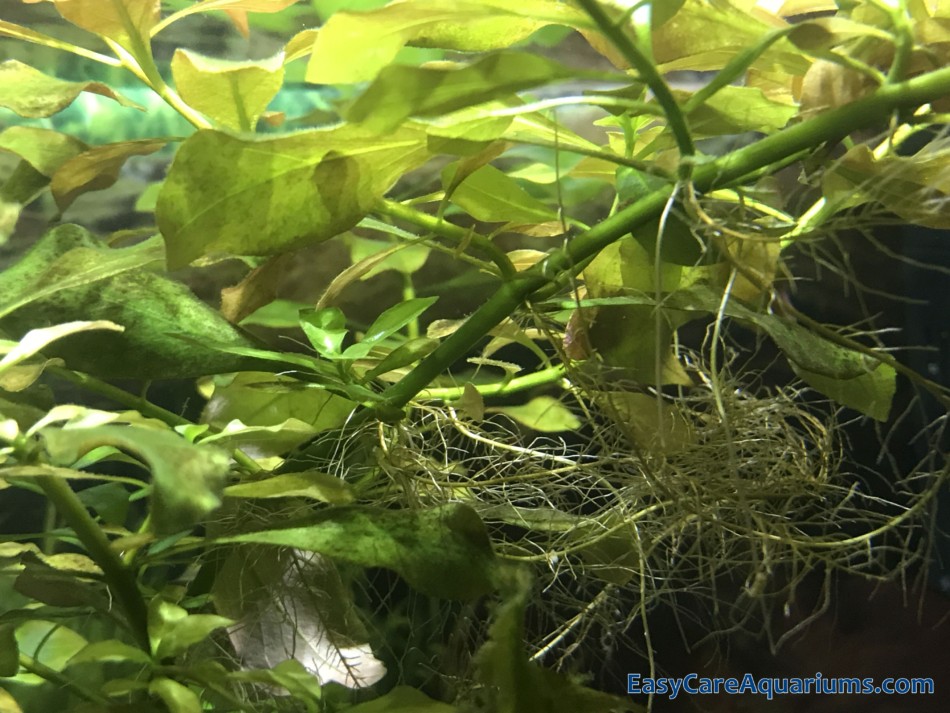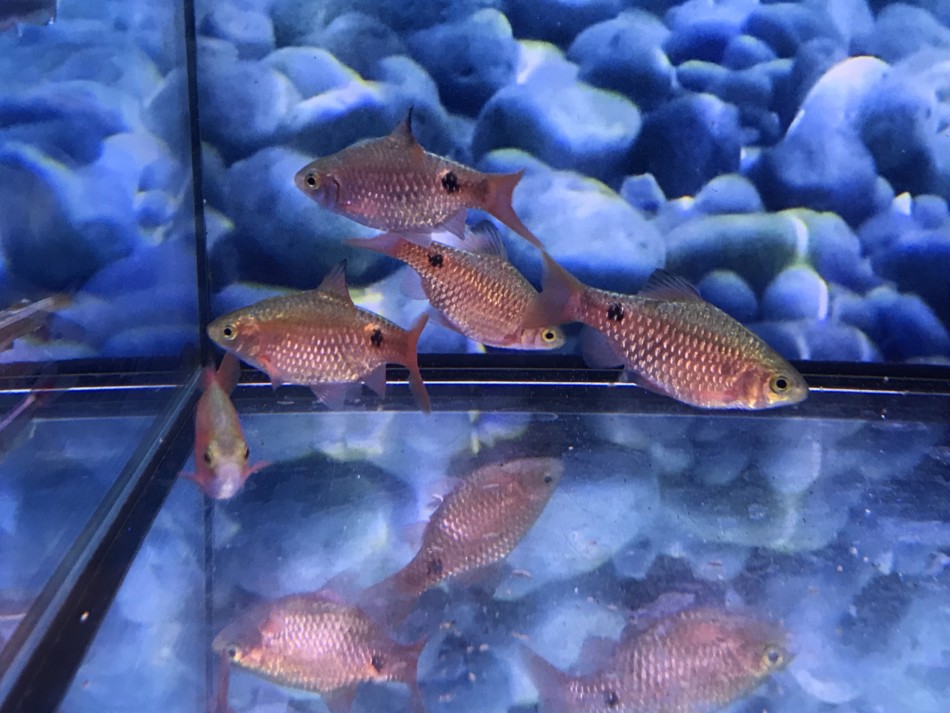This article may contain some affiliate links to products. The links provide me a small percentage of commission but do not cost you anything extra to use. (See full disclosure statement here ).
).
Rosy Barbs are egg scatterers and they’re considered easy to breed in the home aquarium. So, as long as you have both males and females you’re in with a chance of increasing the population of your tank.
Rosy Barbs are an egg scattering fish that breed in shallow water. Because they are egg scatterers it means that they fertilize their eggs externally. As the female is releasing her eggs the male fertilizes them with his milt (semen). The eggs fall amongst the plants. Then the fertilized eggs hatch and develop into Rosy Barb fry (babies).
If they’re happy with the tank conditions you’ll find that your Rosy Barbs will breed regularly. Whether the eggs or the fry will survive is a different matter though.
Let’s take a closer look at how Rosy Barbs breed and how best to protect the eggs and fry
How Can I Tell If My Rosy Barb Is Male Or Female?
The first thing you need to know when it comes to breeding Rosy Barbs is whether you’ve got both males and females in your tank. I know this sounds like and obvious statement but sexing these Barbs isn’t always easy.
In fact, it can be tricky, especially when your Rosy Barbs are young.
However, there a few generally accepted pointers for telling males from females as the fish mature.
- Males are slightly larger than the females but are more slender
- Males have more colour than the females. Their colour can vary from pinkish orange, to reddish orange. There are lots of colour variations in the male Rosy Barb but in general the male’s colour is brighter than the female’s.
- Females are slightly smaller than the males and are plumper around the middle.
- Females are paler in colour. Their colour can vary between silver, gold and even a slight green tint. Either way they lack the reddish colouration of the males.
The best solution to getting both sexes at the start is to ask for a mix of both males and females when you buy them. But don’t be surprised if even your Pet Store or Aquatic Dealer get it wrong despite their best efforts. It really is that difficult to determine their sex when they’re young.
Another way to increase your chances of getting both males and females is to keep them in a decent sized group. Because Rosy Barbs are a schooling fish they prefer to live in a group of at least 6 as a minimum. The more you keep together the happier they will be. You’ll also stand a better chance of them breeding. And keeping them in higher numbers also helps to dilute any aggression.
How Will I Know That My Female Rosy Barb Is Ready To Breed?
When a female Rosy Barb is ready to breed her belly will swell. So you’re going to notice that she looks fatter than usual. And unless you’ve been overfeeding your tank it’s a good indication that your female Rosy Barb is in breeding mode.
Her swollen belly is due to the eggs she is carrying ready for their release during mating (spawning). And because Rosy Barbs are egg scatterers the eggs are unfertilized at this point. Which means that you can’t describe the female as being pregnant. Nonetheless, she is ready to reproduce young.
You may also notice that the female isn’t quite as active as normal due to her increased size and weight.
What Does Rosy Barb Breeding Behaviour Look Like?
Once your female Rosy Barb is plump with eggs and ready to breed you will notice a change in the behaviour of the males. Although they’re always a lively fish the males will now become super energetic in their efforts to breed with the female. And their colour will become even brighter than usual.
The males will energetically chase the female(s). The behaviour of the males towards each other can become quite aggressive until one male and one female become a mating pair. Once the paring has been established the serious business of spawning begins.
Rosy Barb Spawning Behaviour
Spawning is the time when a female Rosy Barb releases her eggs and they are fertilized by the male. The male encourages the female to release her eggs by nudging and pushing her until she is ready to release them. As she is releasing the eggs the male fertilizes them by coating them with his milt (semen).
Rosy Barbs generally spawn amongst the plants but they will also happily spawn in a spawning mop.
Because spawning usually happens at dawn, or in the early hours of the morning, it can be difficult to get the chance to see it happening. So unless you’re an ‘early bird’ you might not even know that it’s happened.
What Do Rosy Barb Eggs Look Like?
Rosy Barb eggs look like minute pearls and are generally just about a millimetre in diameter. The eggs are sticky which helps them to attach to plants etc. They are visible to the naked eye if you know what to look for. Whether you will be able to see them or not will depend on where the eggs land.
Rosy Barb eggs can be difficult, if not impossible, to spot amongst the plants and substrate of an aquarium. So don’t be too surprised if the first thing you notice after your they have spawned is the tiny fry swimming around the tank looking for food.
How Many Eggs Do Rosy Barbs Scatter At A Time?
Rosy Barbs can scatter hundreds of eggs during each spawning session. Whether all of the eggs will be fertilized successfully will depend on the ability of the male to fertilize the eggs once they’re released. So you may find that some, or all of the eggs, are not viable.
However, as the saying goes ‘practice makes perfect’. So, even if the first few spawns result in only a small percentage of the eggs being successfully fertilized, you may find that over time your Rosy Barbs get better at it.

How Long Does It Take For Rosy Barb Eggs To Hatch?
As a general rule, and depending on tank conditions and temperature, it takes between 24-48 hours for Rosy Barb eggs to hatch. When they have hatched these tiny fish are only about 2 millimetres or so long and are often referred to as wigglers. The reason for this name is because that when Rosy Barb fry hatch they wiggle rather than swim at first.
During their time as wigglers they feed off their yolk sac. Once their yolk sac is used up, which can be up to about 5 days, they become free-swimming and are then called fry. This is when they set off in their search for food.
When Rosy Barb fry are swimming freely in the aquarium they are easier to see. Which means you’ll have a better idea of how many new fish you have in the tank. And also how much extra food you will need to put into the tank.
All food for Rosy Barb fry needs to be small enough for them to eat. If you would like more information about what to feed your Rosy Barb fry, and also what to feed the adults, take a look at my article ‘What Do Rosy Barbs Eat? ‘
‘
Do Rosy Barbs Eat Their Own Eggs And Fry?
Rosy Barbs are non-parental to their offspring which means that they will eat their own eggs and fry. In fact a breeding pair will eat the eggs as soon as they are released during spawning. Any eggs that escape being eaten, and hatch out into wigglers, will also be eaten if they are caught by the adult fish. The same goes for the tiny free-swimming fry too.
If you want to save as may Rosy Barb eggs/fry as possible there’s a few tips below that will help you to do that.
Tips For Saving Rosy Barb Eggs/Fry
- Set Up A Breeding Tank – The best way to save as many eggs and fry as possible is to set up a separate cycled breeding tank. Rosy Barbs breed in shallow water so keep the water level low. You also need to add plants or a spawning mop to encourage breeding. The tank can have a grid platform, marbles or round pebbles, at the bottom for the eggs to fall through so the adults can’t eat them. Put your Rosy Barbs (preferably 1 male and 2 females) into the tank and let them spawn. Once all the eggs have been released remove the adult fish and put them back in their original tank. The breeding tank can then be used as a hatchery and nursery.
- Have Densely Planted Areas – Having densely planted areas in your aquarium will give eggs/wigglers/fry safe places to hide in while they grow. So if you don’t want to set up a breeding/nursery tank, plants help to make your main tank as safe as is possible for new arrivals.
- Cover Filter Intakes – Aquarium filter intakes are another danger to Rosy Barb wigglers/fry. Open gridwork filter intakes, and open ended intake tubes, can suck in and kill these tiny little fish. So as a precautionary measure it’s best to cover the intakes. How you do this will depend on the type of filter you are running. For example, if you have an open intake filtration tube you can put a pre-filter sponge cover over the end. If you have an internal ‘box type’ filter with a grid inlet you can cover it with a fine mesh (such as ladies tights/pantyhose). If you have a sponge filter run by an air pump you won’t need to do anything because this type of filter is fry-friendly.
If you would like more information about sponge filters read my article ‘What Is An Aquarium Sponge Filter? ‘
‘
Other Frequently Asked Questions
How Big Do Rosy Barbs Get?
Rosy Barbs grow to between 4-6 inches (Approx. 10-15 cm) in an aquarium. But they have been known to get even bigger in their native habitat. So it’s important to keep them in a tank that’s large enough to give them plenty of swim room.
At What Age Do Rosy Barbs Breed?
Rosy Barbs are likely to start breeding between the age of 8 months to 1 year. When they will actually breed though will depend on the individual fish and the tank conditions that they live in.
How Long Do Rosy Barbs Live For?
Rosy Barbs typically live for up to 5 years. But it does depend on the individual fish, their aquarium conditions and diet.
What’s The Male To Female Ratio For Rosy Barbs?
If you’re keeping Rosy Barbs it’s best to have a 1:2 male to female ratio. That means 1 male for every 2 females as a minimum. The more females you have compared to males will help dilute aggression between the males. Which makes for a happy aquarium.
Are Rosy Barbs Aggressive?
Male Rosy Barbs can be aggressive towards each other. Particularly when they are trying to get the attentions of a female for mating. Rosy Barbs can also be aggressive towards other tank mates if the Rosy Barbs are not kept in a decent sized group of their own kind within a community tank. But overall, Rosy Barbs are considered to be a good community fish.

